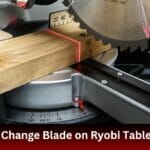Adjusting the fence on a Dewalt table saw is crucial for ensuring accurate cuts. To adjust the fence, first, check the fence alignment to the blade, then check the fence alignment with the rip fence clamp. Then adjust the fence alignment to the blade using the bolts attached. This article describes all the steps for learning how to adjust dewalt table saw fence in detail below.
Of course, since this article is specifically about adjusting the Dewalt Table Saw Fence, you might have a few more general questions about How to Adjust a Table Saw, in which case we’re happy to help as well.
But without further ado, let’s get into the process!
Step 1: Collect The Tools You Need to Adjust Dewalt Table Saw Fence
These tools include the following:
- Combination square, 4 in. In the absence of one, a ruler will do.
- wrench or hex key set
- Table saw with rip fence
- Shop-Vac
- Some wood for testing cuts.
Note: If you’re thinking of test cuts, go the extra mile and check whether your table saw is the perfect height as well for the best results. Learn more about how high a table saw should be here.
Step 2: Checking the Fence Alignment to the Blade
Regaining access beneath your table saw requires removing all materials and connecting a shop vac. Including the outlet itself, unplug any wires from electrical sources. Lift the blade guard, and if you have a wrench or hex key that fits, remove the lower part of the splitter from underneath it.
For earlier machines, this will probably be an Allen head size. In order to prevent swaying while making cuts at high speeds, ensure the arbor nut is tight. Remove the table saw’s power cord from the outlet and set a scrap piece of wood on the table that is about four inches broad.
Make sure it doesn’t move while making this adjustment by positioning a combination square on one of the little flat areas of the table saw’s top surface with its right-angled lip facing you. If your fence is off, use an Allen wrench or hex key to loosen (but do not remove) two adjacent screws on the end cap.
If your model has three, these screws will be spaced at 120-degree intervals or at another particular spacing made just for your saw. When measuring from edge to edge, carefully slide the fence until the left side is exactly aligned with where it meets the blade.
Note: Make sure no part of your combination square is touching any part of the rip fence.
To keep this new position in place, tighten both screws. One of the most crucial actions to keep your saw in tune and cut straight, accurate pieces is to check the alignment of your fence to the blade.
Speaking of alignment to the blade, it might also be difficult if your blade ends up needing adjustment. But even if that happens, don’t worry too much! Check out our guide on aligning a table saw blade and fix any issue that arises.
Step 3: Checking Fence Alignment with Rip Fence Clamp
Re-plug your table saw and turn it on with everything you’ve done so far still in place. Before moving on, let it take a few minutes to warm up; we don’t want any unpleasant mishaps! Keep your shop vac available as well because we’ll need it once we make the cuts.
If you have a splitter system, raise it or take it out while lowering the blade guard (this should be much easier now if you previously removed it).
At each location where the rip fence clamp hits the tabletop, take a measurement from edge to edge. As you slowly slide your combination square out until its lip is one inch from a table edge and one inch from the rip fence itself, keep your combination square motionless.
Once you’re confident that it won’t move while you measure, measure up both sides by a full inch each to make sure all points are covered.
Repeat this along both edges for a total of four measurements; we want to make sure we cover all the bases! Prepare your shop vac and prepare ready to make changes if any region is off by more than 1/32′′ (the thickness of a piece of paper) in order to fix this issue.
The ideal location for doing this would be on a solid workbench or a flat surface like concrete.
On the other hand, you could also make a table – we offer a guide on building a miter saw table which can also be used to multipurpose DIY creations.
Step 4: Adjusting the Fence Alignment
The first thing you should do is move the fence from its current location if you find that it is off by more than 1/32′′ on both measures. The same screws we tightened earlier on the end cap can be loosened in order to achieve this by pulling the entire fence away from the screws until it becomes loose.
Before releasing those screws, slide it as far in that direction as you can if all of your measurements are off in the same direction. Your wood scrap should still be spread out between these two places; measure it again from edge to edge to see if any areas have changed since the previous measurement.
If so far, everything appears to be in order, reinstall your fence and tighten the screws. Remember that we want it to be as near to perfect as we can make it! You will need to tweak two nearby screws on the end cap this time if all measurements still show a discrepancy of 1/32″ in any direction.
If there is only one screw, loosen it until you figure out what adjacent refers to in relation to its location on the fence. These will be located at 120-degree intervals or another specific interval for your saw that can only be discovered through trial and error.
When measuring from edge-to-edge, remember which direction you need to travel from there and tighten/loosen accordingly until everything checks out okay. This makes sure that every cut is straight.
It may sound a bit complicated, but once you’re doing it, it gets a little easier. Feel free to peruse a practical demonstration through a video showing how to adjust dewalt table saw fence to figure out the details of this step:
Step 5: Making Fence Alignment Adjustments on the Table Saw
Before beginning, make sure your table saw is completely unplugged for your protection. It will be considerably simpler to maintain the level if you leave the workbench where you’ve been making modifications because it has a solid top. If you’ve been operating your table saw exclusively, it will also work, but if you decide to do that moving forward, exercise extra caution.
It is easy to check alignment for squareness, and doing so can have a significant impact on how well your projects turn out.
Place both ends of the fence flush against the points where they meet the earlier-used wood scraps to adjust it to the blade using measurements from a dial indicator. If your fence isn’t straight, you’ll need to make a small adjustment in the other direction to make it so.
Watch how much deflection there is as the table saw cuts through both pieces of wood while you plug in your dial indicator. Adjust the blade till this step can be completed if it doesn’t completely cut through each component.
FAQ
Why Do You Need to Adjust DeWalt Table Saw Fence?
- The component of the table saw called the fence helps you to cut a piece of wood in a straight line.
- A higher fence can assist shield your body from cutting-related debris and stopping small parts from flying off.
- Most fences may be adjusted to accommodate differences in blade height.
- To aid in making straight cuts along the length of a piece of wood, some fences incorporate an adjustable “rip fence.”
- To help prevent the blade from pinning parts against the fence, some fences incorporate an adjustable “splitter.”
moreover, if you’re interested in learning in detail about the DeWalt table saw, feel free to peruse the manual for your table saw as well.
Conclusion
Straight cuts are easily created with little effort by adjusting the fence. Safety and home improvement projects both depend on a properly fitted table saw fence, so be sure to adjust your table saw fence if needed. Still, we wish you the best of luck now that you’ve learned how to adjust dewalt table saw fence!
Learn more table saw knowledge with “How much does a table saw weigh?”








